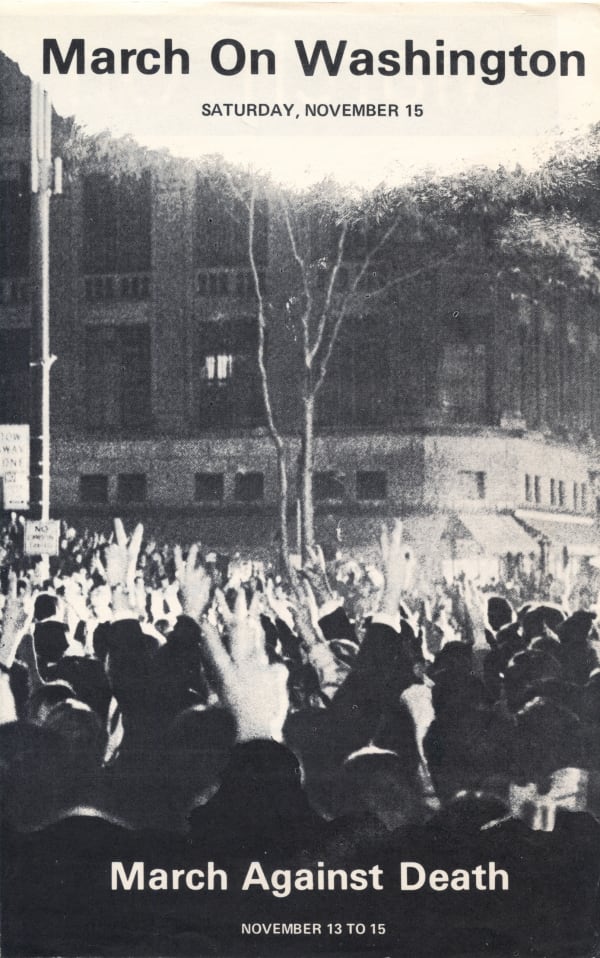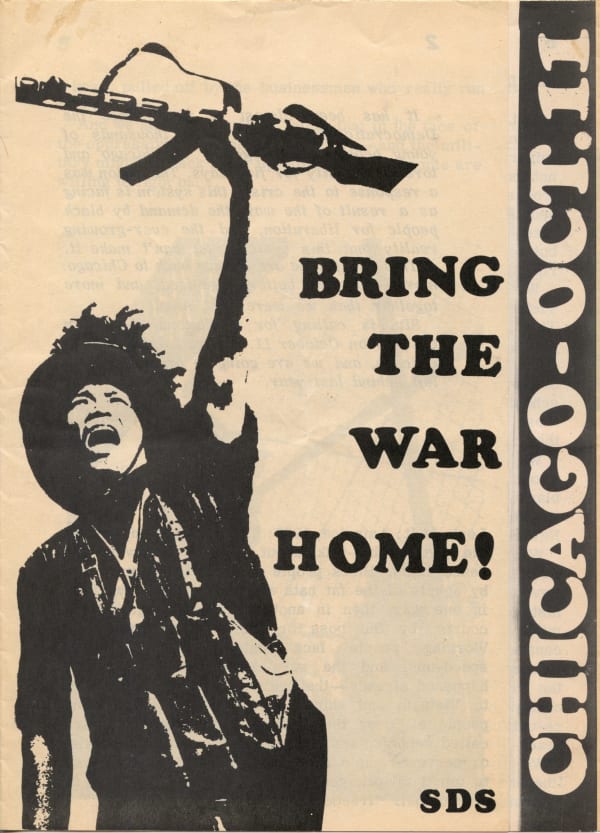-
Independent 20th Century
Specific Object at Susan Inglett Gallery -
Susan Inglett Gallery is pleased to present SPECIFIC OBJECT AT SUSAN INGLETT GALLERY at the Independent 20th Century Fair. The works included will explore the art and socio-political tumult of 1969 through a wealth of artist publications, editions, ephemera and printed matter dating from that year, all drawn from the holdings of Specific Object.
-
 HELP END DEMONSTRATIONS: END THE WAR! MARCH AND RALLY FOR PEACE, 1968
HELP END DEMONSTRATIONS: END THE WAR! MARCH AND RALLY FOR PEACE, 1968 -
I CAN’T SEE HOW I CAN BE OUTSIDE OF THE SOCIETY— SO I’M WITHIN IT.
Text : David Platzker -
1968 and 1969 mark two years of intense amplification in a decade of change. As the period was coming to a close, New York City, America, and the world at large were experiencing materially shattering revolutions, many of which were driven by a roiled counterculture.
-
 YAYOI KUSAMA, CENTERFOLD FOR SCREW: THE SEX REVIEW, NOVEMBER 11, 1968.
YAYOI KUSAMA, CENTERFOLD FOR SCREW: THE SEX REVIEW, NOVEMBER 11, 1968. -
Goldstein’s rationale for including the image was multifaceted. Images of other Kusama events had already appeared in other periodicals. They allowed for journalists to cover stories of orgies, “kooky” loft parties, and staged art events, clothed and otherwise, at the Statue of Liberty, on Wall Street, and elsewhere around the island of Manhattan. They made life in the city appear fun and full of odd opportunities to be a part of it all.
-
-

YAYOI KUSAMA, KUSAMA PRESENTS AN ORGY : NUDITY, LOVE, SEX & BEAUTY FOR ADULTS OVER 21 [REPRINT EDITION] VOL. 1, NO. 2, 1969/2001
-
 AL GOLDSTEIN, JIM BUCKLEY, MARY PHILLIPS, LEAH FRITZ, ALBERT GERBER, JOANNA DANNERS, BILLY GRAHAM, RICHARD FIELD, MIKE HOC, MICHAEL PERKINS, LIGE AND JACK, DAN GRAHAM, BILL GRIFFITH, Screw: The Sex Review (September 1, 1969), 1969
AL GOLDSTEIN, JIM BUCKLEY, MARY PHILLIPS, LEAH FRITZ, ALBERT GERBER, JOANNA DANNERS, BILLY GRAHAM, RICHARD FIELD, MIKE HOC, MICHAEL PERKINS, LIGE AND JACK, DAN GRAHAM, BILL GRIFFITH, Screw: The Sex Review (September 1, 1969), 1969
-
-
That Kusama, Warhol, and other artists were willing to provide content for Screw also gave Goldstein some cover, suggesting the possibility that what he was publishing was more than simply prurient content. He’d argue in front of a judge soon thereafter—not in so few words—that he was providing a platform for expression. Sure a lazy reader might believe it was just sex, but as the publisher his was a righteous—and profitable—cause providing the ink and paper onto which the day’s culture was reflected. At root, Screw could be a locus for art—albeit principally of a sexual nature. The proliferation of newsstands in the city provided a network for wide distribution, however, the site where Screw was consumed was immaterial. The publication was primarily an exhibition space, a theatre for the mind.
-
 Amalo, Alan Martin, Dean Latimer, R. Crumb, King Albert, Pearl N. Joying, Frederick Worthjam, Joe Fabricant, Peter Mikalajunas, KISS Vol 1, No. 2, 1969
Amalo, Alan Martin, Dean Latimer, R. Crumb, King Albert, Pearl N. Joying, Frederick Worthjam, Joe Fabricant, Peter Mikalajunas, KISS Vol 1, No. 2, 1969 -
Artists did not limit their interventions to editorial alone; Warhol placed advertisements for his movies in the publications, and Dan Graham took out personal ads in four issues of the New York Review of Sex & Politics, and one issue of Screw, each ad containing a variation of the following text:
-
WANTED: Professional medicalwriter willing to write clinicaldescription covering equally thephysiological and psychological(lassitude/pleasure) response tothe human male to sexualdetumescence. The descriptionselected will be reproduced as apoem in a national magazine.Writer of piece retains copyrightAnd is free to use description forhis own purposes. Contact: DanGraham, 84 Eldridge St., NYC,10002
-
In the August 1, 1969, issue of the New York Review of Sex & Politics Graham’s personal ad, Detumescence, would appear on the same page as artist Robert Cenedella’s advertisement for his poster SHIT—a parody of Robert Indiana’s ubiquitous LOVE— Cenedella’s proof of concept that SHIT could sell.
-
Kusama, also in 1969, after several years of figuring prominently in the contents of many men’s magazines, would found her own tabloid, Kusama Presents An Orgy: Nudity, Love, Sex & Beauty For Adults Over 21, where she could be the mastermind between the sheets, not simply a side act presented by male editors.
-
-
In an era where the artistic groundswell was shifting from Pop and Minimal art towards Conceptualism, the critical dialogue became heavy with talk of the “dematerialization of the art object.” [1] And, while much of the art being produced in 1969 was pushing against the boundaries of traditional painting and sculpture, it’s not entirely fair to say art was dematerializing. In fact, art was becoming decentralized, artists were finding ways to produce works that could circulate broadly.
-

artists poster committee of art workers coalition, frazier dougherty, jon hendricks, irving petlin, r.t. haeberkle, Q. and babies? a. and babies, 1969/ 1970
-
 JAN DIBBETS, Untitled (Postcard), 1969
JAN DIBBETS, Untitled (Postcard), 1969 -
![For the month of March 1969, he published March 1969 [also known as One Month], for which he invited Terry...](data:image/gif;base64,R0lGODlhAQABAIAAAAAAAP///yH5BAEAAAAALAAAAAABAAEAAAIBRAA7)
SETH SIEGELAUB, TERRY ATKINSON, MICHEL BALDWIN, ROBERT BARRY, RICK BARTHELME, N.E. THING CO., JAMES LEE BYARS, JOHN CHAMBERLAIN, RON COOPER, BARRY FLANAGAN, ALEX HAY, DOUGLAS HUEBLER, ROBERT HUOT, STEPHEN KALTENBACH, JOSEPH KOSUTH, CHRISTINE KOZLOV, RICHA, MARCH 1969 [aka : One Month], 1969
-
While men dominated Siegelaub’s gallery and publications—with the sole exception of Christine Kozlov who was included in a single project—he hired Adrian Piper to be his secretary for the duration of his last physical gallery show, January.
Piper, between her gallery responsibilities, clandestinely copied Siegelaub’s Rolodex, utilizing the dealer’s mailing list to distribute copies of her artist’s project, a set of three untitled books she intended as independent works titled Three Untitled Projects [for 0 to 9]: Some Areas in the New York Area (1969).By mailing copies of the book packed in manila envelopes to a wide network of 162 artists, collectors, critics, curators, dealers, friends, writers, and others, Piper’s project was understood not just as an independent mail-art exhibition, but as Piper's first exhibition. The names and addresses of those who received the books were indexed in two columns on both sides of a loose sheet of paper included in the envelope, with a red dot placed next to the recipient’s name on the list in the packet that he or she received: each recipient's address was thus designated as a location of the exhibition.
Each of these four elements—the three books and the index of names—demonstrates a distinct means of documenting and naming locations. The first book records the locations found at the intersections of horizontal and vertical creases on a standard Hagstrom map of New York’s boroughs; the second book illustrates the area of a randomly chosen block in Manhattan—the area between Second and Third Avenues bordered by East Forty-seventh and East Forty-eighth streets, identically marked in red ink in each copy—proportionally translated into increasingly smaller dimensions; the third book deconstructs four sheets of graph paper, using descending grid sizes and various measurements for the boxes on each of the four sheets (1/4 inch, 1 pica, 1/8 inch, and ten squares to 1 inch, plus an equation to show how the fixed gridded scales could theoretically be extended to larger dimensions; and the sheet of the recipients’ names and locations places the work in the here and now of the physical world.)
-
![Adrian Piper, Three Untitled Projects [for 0 to 9]: some areas in the new york area, 1969](data:image/gif;base64,R0lGODlhAQABAIAAAAAAAP///yH5BAEAAAAALAAAAAABAAEAAAIBRAA7) Adrian Piper, Three Untitled Projects [for 0 to 9]: some areas in the new york area, 1969
Adrian Piper, Three Untitled Projects [for 0 to 9]: some areas in the new york area, 1969 -
The effect of the second book is not unlike that of Kees Boeke’s classic publication Cosmic View: The Universe in Forty Jumps, where forty “jumps” take a reader from a woman sitting in a chair with a baby in her arms to outer space, 2 billion light years away.
The triptych publication, in concert with its means of distribution, expanded on Adrian Piper’s inquiry into spatial relationships as fixed constructions defined by the limits of the human mind. By putting the project directly in the hands of her influential intended recipients, Piper utilized one of the significant strengths of artists’ books, which is to extend works of art to individuals—domestically and internationally—who might not otherwise see the work in a gallery setting. Piper’s project became a primary example of how publications traverse not just fixed locations, but the durational nature of presenting art in fixed locations. [2]
The seemingly insular nature of conceptual work should not be experienced as if it were crafted in a vacuum. Artists, their friends, families, dealers, critics, supporters, and the broader society were deeply engaged in the events that impacted the world at large. -
-
 WOMEN STRIKE FOR PEACE, MOTHERS DEMAND THIS MUST STOP, 1969
WOMEN STRIKE FOR PEACE, MOTHERS DEMAND THIS MUST STOP, 1969 -
 DAVE DELLINGER, CORETTA KING, DR. BENJAMIN SPOCK, GEORGE WALD, ARLO GUTHRIE, JIMI HENDRIX, RICHIE HAVENS, PETER, PAUL & MARY, TOM PAXTON, March Against Death - March on Washington, 1969
DAVE DELLINGER, CORETTA KING, DR. BENJAMIN SPOCK, GEORGE WALD, ARLO GUTHRIE, JIMI HENDRIX, RICHIE HAVENS, PETER, PAUL & MARY, TOM PAXTON, March Against Death - March on Washington, 1969 -
 SDS / STUDENTS FOR A DEMOCRATIC SOCIETY, Bring the War Home, 1969
SDS / STUDENTS FOR A DEMOCRATIC SOCIETY, Bring the War Home, 1969
-
-
In 1969, and the years immediately before and after, fervent topics of the day included many if not the same topics that concern us today. Abortion, civil and LGBTQ rights, a political landscape in turmoil, marijuana legalization, art institutions favoring white men over women and artists of color, and war indiscriminately killing women and children all echo the issues that drew protests 53 years ago.
-
 DOUGLAS HUEBLER, LOCATION PIECE #13 (WASHINGTON MARCH), 1969
DOUGLAS HUEBLER, LOCATION PIECE #13 (WASHINGTON MARCH), 1969 -
Institutions—museums, collectors, historians—tend to favor art they can easily categorize with a goal of creating a tidy discourse tracing the trajectory of art history, like “a torpedo moving through time, its nose the ever advancing present, its tail the ever receding past of 50 to 100 years ago.” [3]
Yet, artists are individuals. They are not simply the creators of art but also the embodiment of the culture within which they live. The romantic notion that art is crafted in isolation, walled off from larger society is a fallacy. Artists, particularly of the late 1960s, were active participants in all aspects of the world around them.
As Donald Judd—the artist who most exemplifies an art of unadorned specific objects—would write in June 1968, “Any art involves philosophical, social and political attitudes. It’s hard to generalize about all art and the United States but essentially the best art is opposed to the main kinds of power and to many of the prevailing attitudes. I can’t see how I can be outside of the society, which is a wish sometimes, so I’m within it.” [4] -
 CLAES OLDENBURG, Fireplug Souvenir - "Chicago August 1968", 1968
CLAES OLDENBURG, Fireplug Souvenir - "Chicago August 1968", 1968 -
-
Notes
[1] This phrase was originally coined in 1967 by Lucy Lippard and John Chandler in “the dematerialization of art,” Art International 12, no. 2 (February 1968): 31-36.[2] Text regarding Three Untitled Projects [for 0 to 9]: Some Areas in the New York Area adapted from Platzker, David. "Adrian Piper: Unities." In Adrian Piper: A Synthesis of Intuitions" ed. by Christophe Cherix, Cornelia Butler, and David Platzker, (New York: The Museum of Modern Art, 2018).
[3] Alfred H. Barr Jr. “Report on the ‘Permanent Collection,'” The Museum of Modern Art, New York, 1933.
[4] Donald Judd, statement in “La Sfida del Sistema,” Metro 14, (June 1968), reprinted in Donald Judd: Complete Writings 1959 - 1975, Gallery Reviews, Book Reviews, Articles, Letters to the Editor, Reports, Statements, Complaints, (Halifax, Canada: The Press of the Nova Scotia College of Art & Design, and New York: New York University Press, 1975), 196.
-
David Platzker is an art historian, curator, writer and art dealer. His work centers on art after 1958, with an emphasis on Pop, Fluxus, Minimal, and Conceptual art—what informed those movements and successive generations of artists whose work follows formally and intellectually from these precursors.
Between 1998 and 2004, Platzker was the Executive Director of the non-profit bookstore Printed Matter. In 2004, he founded Specific Object, a gallery and think tank dedicated to ephemeral materials of the 1960s forward. From 2013 until February 2017, Platzker was Curator of Drawings and Prints at The Museum of Modern Art, where he co-curated the exhibitions "There Will Never Be Silence: Scoring John Cage’s 4’33" (2014), "Sites of Reason" (2014), "Gilbert & George: The Early Years" (2015), and "Adrian Piper: A Synthesis of Intuitions" (2017), which traveled to the Hammer Museum of Art, Los Angeles, under the title "Concepts and Intuitions, 1965–2016" (2018).
In 2018 Platzker resumed his role as president of Specific Object, contributing essays to the monographs "Charles Gaines : Palm Trees and Other Works" (Hauser & Wirth, 2019); "John Baldessari Catalogue Raisonné: Volume Six: 2011-2019" (Yale University Press, 2021); and the forthcoming publication "Ed Ruscha: An Archive of Projects" (Gagosian Gallery, 2023).
INDEPENDENT 20TH CENTURY: Specific Object at Susan Inglett Gallery
Past viewing_room



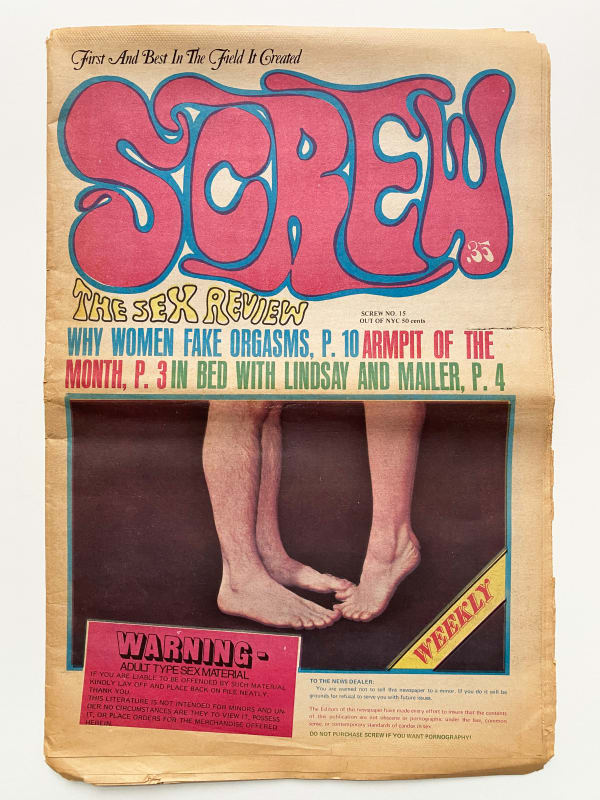
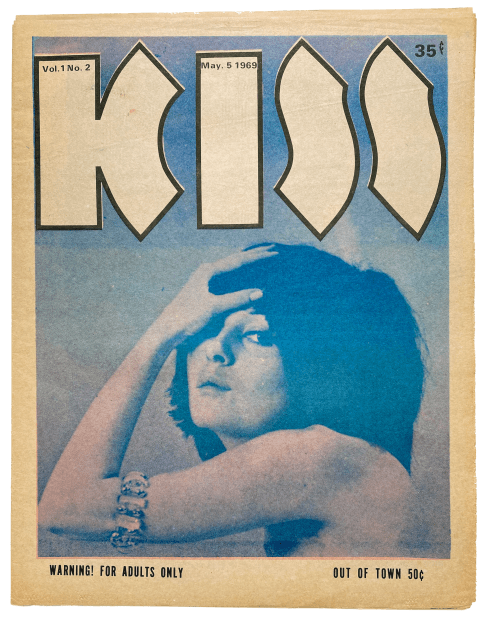
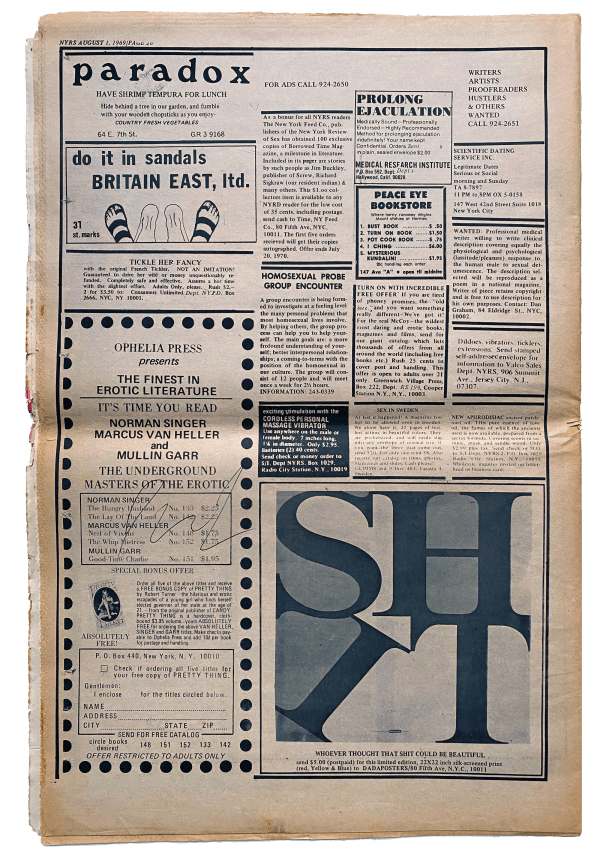



![For the month of March 1969, he published March 1969 [also known as One Month], for which he invited Terry...](https://artlogic-res.cloudinary.com/w_620,h_620,c_limit,f_auto,fl_lossy,q_auto/artlogicstorage/susaninglett/images/view/4930bc08121b9a2d9f8a7aa487a9a67ej.jpg)
![Adrian Piper, Three Untitled Projects [for 0 to 9]: some areas in the new york area, 1969](https://artlogic-res.cloudinary.com/w_3000,c_limit,f_auto,fl_lossy,q_auto/artlogicstorage/susaninglett/images/view/75a79471972ef2043482cec8c24cd39bj.jpg)

